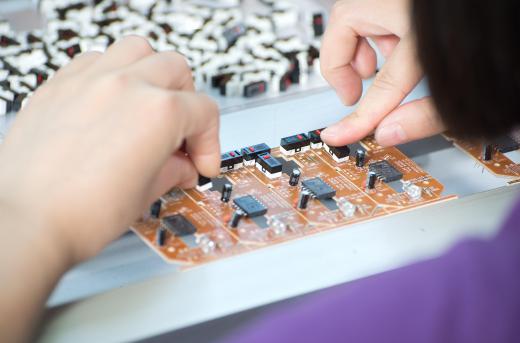In general, PCB assembly process involves preparation of the printed circuit board's surface, placing the components, soldering, and testing the completed item. Completed boards must pass through thorough testing before being released to a different part of a production line for attachment to a housing, such as a cell phone. This process is normally done through automated machines, but it is possible to make a homemade PCB with some modifications.
PCBs have specific points on their surface that can hold components; the first step in the PCB assembly process is applying solder paste across a screen. A machine places screens across the areas intended for the future components. Solder paste is spread across the screen to allow it to drip down onto the PCB's surface. This paste is meant to hold the future components to specific points on the PCB for a secure circuit connection.

Machines place components onto the solder paste in the next step of the PCB assembly process. A computer program controls the machine; it chooses particular components from a supply line and physically places them on the board. Solder paste provides the adhesion to hold the components in place before the soldering process.
Reflow soldering must follow the placement of the components so that they do not detach from the board. This part of the PCB assembly process requires the board to be placed in a reflow oven; the heat from the oven melts the solder paste so that the components are permanently attached to the PCB. Each manufacturer has a different temperature range that is strictly controlled to prevent damage to the board's circuitry.
After the board cools, it must be thoroughly tested during the PCB assembly process. Assembly line workers or quality assurance specialists will attach the board to a test device; each function and circuit must be powered and checked for functionality. Any defects or poor circuit connections must be re-soldered manually or the entire board may be scrapped.
Testing multiple PCBs may produce a common circuit problem through a batch. In these cases, quality managers may have to troubleshoot each PCB assembly process to find the cause of the defect. Entire batches may be pulled and repaired once the cause is pinpointed. Homemade PCBs can be made with hobbyist boards and old style wire components by following a particular schematic to hand solder components into a board's circuitry. For example, a hobbyist may solder a PCB to run a motor for a remote control car.
